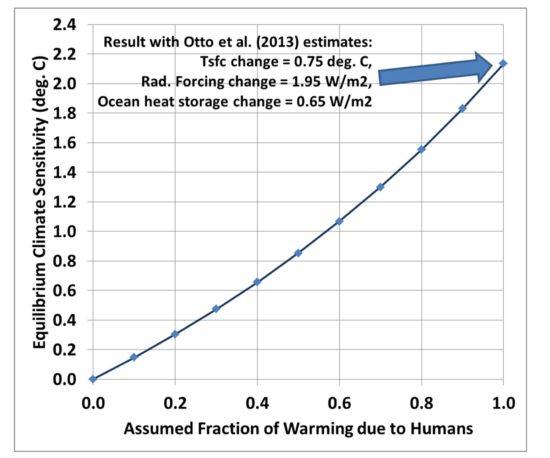Climate sensitivity has been diagnosed based upon energy budget considerations by several authors in recent years using observational data combined with estimates of anthropogenic radiative forcing (e.g. Otto et al., 2013; Lewis & Curry, 2014).
Significantly, they generally calculate a lower equilibrium climate sensitivity (ECS) than the average of the IPCC AR5 climate models. Whereas the IPCC models average about 3.4 deg. C of warming from a doubling of atmospheric CO2 (2XCO2), these diagnostic studies get ECS from about 1.6 to 2.0 deg. C. Nic Lewis has provided detailed analysis over at Judith Curry’s blog about what goes into these estimates and the uncertainties of each observational variable.
The ECS estimate is based upon conservation of energy, and uses four variables in a single equation that uses differences in the climate system at two different times (say, two different decades) sufficiently separated in time where there has been a large climate reponse in surface temperature to an assumed radiative forcing. Note that the climate response is assumed to be a response to anthropogenic radiative forcing, plus volcanoes, and analysis is usually restricted to the oceans (where heat storage can be more accurately estimated):
ECS = F2XCO2[ ΔT/(ΔF – ΔQ)],
where:
F2XCO2 = 3.7 W/m2, the assumed radiative forcing from a doubling of atmospheric CO2,
ΔT = the change in global average surface temperature between two periods (deg. C);
ΔF = the change in radiative forcing (imposed energy imbalance on the climate system at top of atmosphere) between two time periods (W/m2);
ΔQ = the change in ocean heat storage between two time periods(W/m2).
In the aforementioned papers, the earlier time period has been chosen to be in the mid- to late- 1800s, while the second has been some subset of the period 1970-2011.
I have verified the above equation using a time-dependent energy balance model of a 2-layer ocean extending to 2,000m depth using either the RCP6.0 radiative forcing history, or an instantaneously imposed doubling of CO2 back in the 1800s, and I get the same ECS calculated from the model output as I prescribed as input to the model. The equation works.
What if a Portion of Recent Warming Was Natural?
As you might recall, the IPCC is quite certain that the dominant cause of warming since the mid-20th Century was due to anthropogenic forcings.
What does “dominant” mean? Well, I’m sure it means over 50%. This implies that they are leaving the door open to the possibility that some of the recent warming has been natural, right?
Well, we can use the above equation to do a first-cut estimate of what the diagnosed climate sensitivity would be if some fraction of the surface and deep-ocean warming was natural.
All we have to do is replace ΔQ with fΔQ, where f is the fraction of ocean warming which is human-caused. We also do the same thing for the surface warming term: fΔT.
When we do this for anthropogenic fractions from 0% to 100%, here’s what we get:

How the data-diagnosed equilibrium climate sensitivity changes assuming different fractions of the warming due to humans (and the rest natural).
Note that even assuming 70% of recent ocean warming is due to humans (consistent with their claim that humans “dominate” warming), that the diagnosed climate sensitivity is only 1.3 deg. C. which is below the range even the IPCC (AR5) considers likely (1.5 to 4.5 deg. C).
Now, this raises an interesting issue… almost a dichotomy. I have heard some IPCC-type folks claim that recent anthropogenic warming could have been damped by some natural cooling mechanism. After all, the models are warming (on average) about twice as fast as the measurements of the lower troposphere. If they really believe the models, and also believe there has been some natural cooling mechanism going on suppressing anthropogenic warming, why doesn’t the IPCC simply claim ALL recent warming was due to human causation? That would be the logical conclusion.
But the way the AR5 was written, they are suggesting that a portion of recent warming could be natural, which is the basis for my analysis, above, which produces a very low climate sensitivity number.
They can’t have it both ways.

 Home/Blog
Home/Blog



